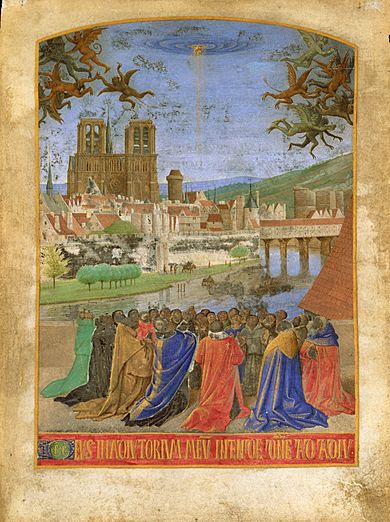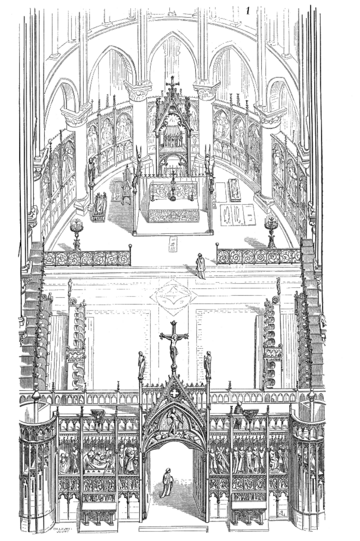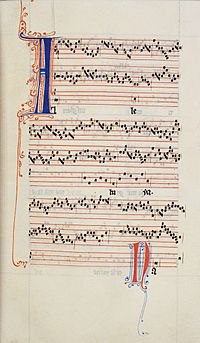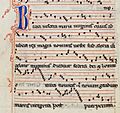Pérotin facts for kids
Quick facts for kids
Pérotin
|
|
|---|---|
| Nationality | French |
| Other names | Perotinus, Perrotinus, Perotinus Magnus, Magister Perotinus |
| Occupation | Composer |
| Years active | fl. c. 1200 |
| Known for | Polyphony |
|
Notable work
|
Viderunt omnes, Sederunt principes, Alleluia Nativitas |
Pérotin (around 1200) was a famous composer from Paris, France. He was part of the Notre Dame school of music, which was known for its new style called polyphony. Polyphony means having more than one voice singing different melodies at the same time. Pérotin helped make this style even better by adding three and four-part harmonies to music.
Most of what we know about Pérotin comes from an English student known as Anonymous IV. This student wrote about Pérotin's music and called him Magister Perotinus, which means "Pérotinus the Master." This title showed that Pérotin was allowed to teach music. People believe Pérotin was French, and his name is a shorter version of "Peter."
Who was Pérotin?

Pérotin lived around the late 1100s and early 1200s. We don't know much about his personal life, but he was a very important composer. He worked at or near the famous Notre-Dame Cathedral in Paris.
He was a key member of the Notre Dame school of music. This group of composers created a new style called ars antiqua, which means "old art." Pérotin was one of the few composers from his time whose name was remembered and whose music was saved. The title Magister Perotinus meant he had a special degree and could teach music. Some people even called him Perotinus Magnus, or "Pérotinus the Great," showing how much they respected him.
Music History and Pérotin
The Notre Dame School

The Notre Dame school of music started around the time King Louis VII ruled France (1137–1180). Before this, most church music was monodic, meaning only one melody was sung at a time, like Gregorian chant. The Notre Dame school changed this by introducing polyphony, where multiple voices sang different parts together. This was a huge step for European church music!
One of the first composers of this school was Léonin. He created two-part songs called organa. In organum, a slow, main melody (called the tenor) was sung, and a faster, more complex melody (called the duplum) was sung above it. This new style also made rhythm very important, which led to music that could be "measured" precisely.
The music from this time was written down carefully. This meant that compositions could be saved and shared, unlike earlier music that was mostly improvised. This was the beginning of thinking about music having specific composers and pieces.
The Great Organum Book
Léonin collected his music in a book called the Magnus liber organi, or "Great Organum Book." Pérotin's music was also added to this important collection. The Magnus liber contains music with two, three, and four parts. It includes different types of songs like organa, clausulae, conducti, and motets.
The book starts with a four-voice song for Christmas called Viderunt omnes fines terrae (meaning "All the ends of the earth have seen"). Many people believe Pérotin wrote this piece. This collection of music is the earliest known example of polyphony that was widely shared and kept for history.
Pérotin's Music Style
Pérotin is famous for his three and four-part polyphony. His pieces Viderunt omnes and Sederunt principes are great examples of his four-part music. Before Pérotin, most polyphony only had two parts. Adding more voices made the music sound much richer and more complex.
When more parts were added, these songs became known as motets. Pérotin's Christmas songs are considered some of his best works. They show how he used many voices to create beautiful harmonies. He also helped improve how music was written down, making it easier for musicians to play his complex pieces.
Pérotin also revised Léonin's Magnus Liber Organi. Léonin's music often had very long sections where one voice sang many notes over a very slow main melody. Pérotin made these parts shorter and added more voices to make the music sound fuller. This made the music more exciting and varied.
Famous Works by Pérotin

Anonymous IV mentioned several pieces that Pérotin composed. These include the four-voice Viderunt omnes and Sederunt principes. He also wrote three-voice pieces like Alleluia "Posui adiutorium" and Alleluia "Nativitas".
Later experts have also said that Pérotin wrote other pieces, like the two-voice Dum sigillum summi Patris and the single-voice Beata viscera (meaning "O blessed womb"). The conductus style, like Beata viscera, was a Latin poem set to a repeated melody, similar to a hymn.
His most famous works are definitely Viderunt omnes and Sederunt principes. These songs are seen as the highest point of music development during his time.
Pérotin's music often used the discant style, where the upper voices moved rhythmically above the slower main melody. This fits with Anonymous IV calling him optimus discantor, meaning "the best discant composer."
We think Pérotin wrote his four-part Viderunt omnes for Christmas in 1198. His other four-part piece, Sederunt Principes, was likely composed for Saint Stephen's Day in 1199, for the dedication of a new part of Notre Dame Cathedral.
Pérotin's Influence
Pérotin is often called the first modern composer in Western music. He changed music from being mostly improvised to having a clear, planned structure. His music has even inspired modern composers, like Steve Reich, who uses similar ideas in his minimalist music.
Recordings
- Psallite! A Renaissance Christmas by Chanticleer (1991)
- Listen to Pérotin's "Benedicamus Domino" from this album.
- Gothic Revolution – Sacred Music by The Sixteen, Harry Christophers
- Messe de la Nativité de la Vierge by Ensemble Organum, Marcel Pérès (1995)
- Perotin by The Hilliard Ensemble
- Sacred Music From Notre-Dame Cathedral by Tonus Peregrinus; Antony Pitts (2005)
Images for kids
See also
 In Spanish: Perotín para niños
In Spanish: Perotín para niños




